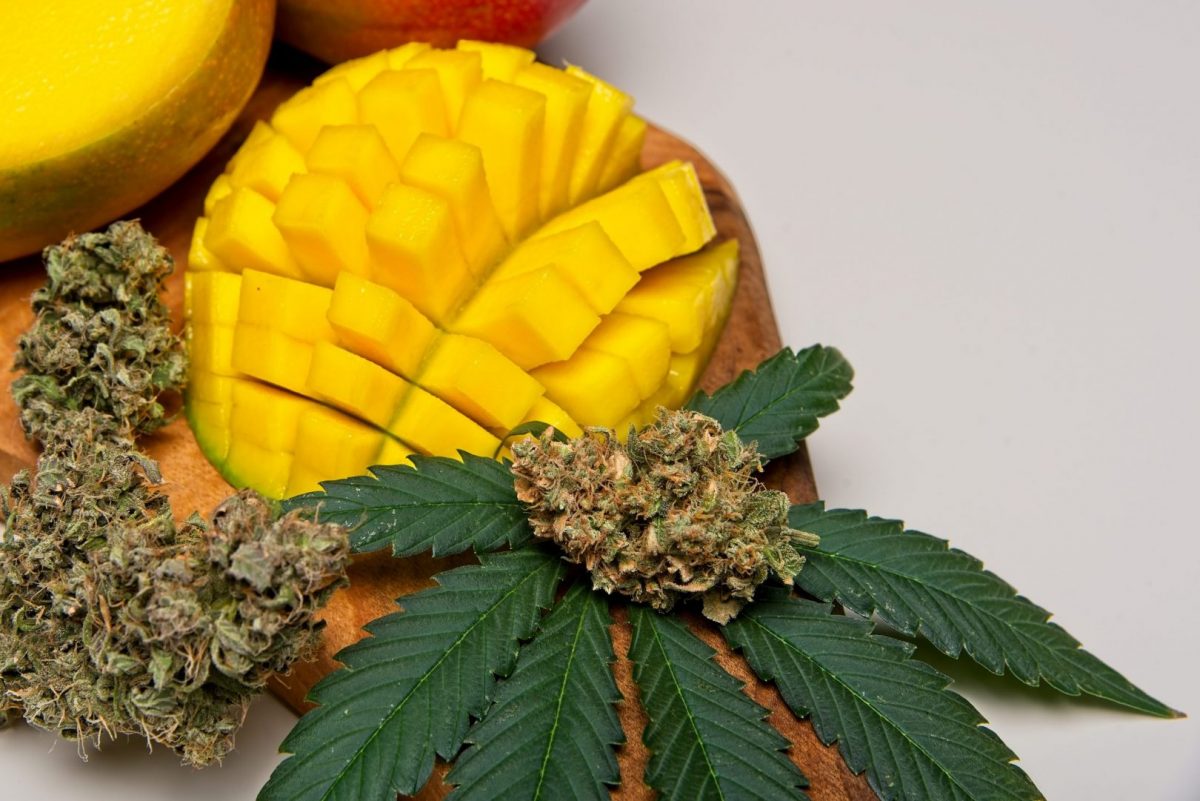A Guide to the Most Common Cannabis Terpenes
The word terpene is searched on the web 5 times more today than it was 10 years ago, yet some people still don’t know what terpenes are or what they’re capable of. In this article, we’ll explore the most common terpenes found in the cannabis plant; what aroma they have, and their potential medicinal effects.
Some articles on the web get all technical and scientific with their explanations of different terpenes. My goal is to make this guide to cannabis terpenes not only a pretty quick read but also; a simple and easy-to-understand explanation about them.
So, without further ado . . .
A Guide to the Most Common Cannabis Terpenes

Myrcene
Myrcene is the number one most common terpene found in the cannabis plant. It is also found in mango, lemongrass, hops, red grapes, and bay leaves. It has a very earthy-musky aroma and taste and gives off undertones of fruit – similar to mango.
For thousands of years, Myrcene has been used as a natural sedative and is the terpene associated with being ‘couch-locked’ or sedated. It also acts as an anti-inflammatory and has powerful analgesic properties (changing the way the brain perceives pain).
It has been said that if a cannabis strain has more than .50% Myrcene, it is an Indica. This is not always true – it is important to look at all of the terpenes as a whole to judge what a strain’s medicinal effects might be. I have seen Myrcene dominant strains that were actually a Sativa because of the levels of other terpenes added together.
The terms “Indica” and “Sativa” ONLY define how a cannabis plant looks – it defines the species of the plant. The effects of a specific strain can ONLY be defined by its terpenes.

Pinene
Pinene is another very common cannabis terpene. There are actually 2 types of it; alpha and beta. Alpha-Pinene has a very fresh pine aroma, whereas Beta-Pinene has a more woodsy-herbal aroma and flavor. I’m sure you can guess what else Pinene is found in – Pine!
Pinene really helps end the stigma that cannabis is just as bad for the lungs as cigarettes! Pinene is actually a well known bronchodilator (opens up the airways and improves lung functions). It also is a natural alternative to popularly prescribed ADD/ADHD medications as it actually aids in memory and attention issues.

Limonene
Limonene is a terpene that can also be extracted from the rinds of lemons and other citrus fruits like oranges and limes. It’s important to note that not all strains with ‘lemon’ in the name are dominant or even high in Limonene.
Limonene gives off a very fresh citrusy aroma and will give cannabis a zesty-lemony taste. Mixed it with Pinene and you get strains that taste like Pine-Sol floor cleaner!
Used also in cleaning products; Limonene has strong anti-bacterial, anti-fungal, and anti-microbial properties. It is also known to elevate a person’s mood, kill cancer cells, and help with anxiety.
A lot of strains that are dominant in Limonene are considered a Sativa; but for many people, Limonene acts more like a calming terpene in regards to anxiety relief and relaxation. Limonene is also known to reduce the potential for anxiety brought on by THC; as is b-Caryophyllene.

Linalool
Linalool is a very floral terpene that is also found in Lavender. It is used in many different things from perfumes to shampoos. I’m sure you’ve already come to the conclusion that Linalool gives cannabis a very fresh floral aroma and taste.
It isn’t found in great quantities in cannabis, but when it’s there; it aids tremendously with anxiety and insomnia. Throughout history, Linalool has been used medicinally as a very powerful sedative and promotes restful sleep.

Beta-Caryophyllene
Known for giving cannabis a woody-peppery-spicy taste and aroma; beta-Caryophyllene is also found in cloves and black pepper. B-Caryophyllene is actually the only terpene that binds to CB2 receptors and has been said to enhance the effects of other cannabis terpenes.
Caryophyllene is known to have anti-inflammatory effects; much like other cannabis terpenes, but it also has very strong anti-anxiety properties. Neil Young once said that if he would start getting anxious from smoking cannabis, that he would gently inhale fresh-ground black pepper and it would ease his anxiety -that’s Caryophyllene hard at work!
If you look at most cannabis strains that have ‘Cookie’ in the name, chances are – it’s dominant in Caryophyllene.
Humulene
Any beer drinker knows all about hoppy flavors; but what about cannabis? Alpha-Humulene is a common terpene that is also responsible for giving beer its distinct hoppy-floral-spicy flavor profile.
Humulene isn’t only found in hops though; it is also present in ginseng and sage. It gives cannabis a very herbaceous, floral yet spicy taste and aroma. For thousands of years, it has been used as an anti-inflammatory, anti-fungal, and powerful analgesic (pain reliever).
Alpha Humulene is so very closely related to b-Caryophyllene; that it was formerly known as Alpha-Caryophyllene until it was reclassified as alpha-Humulene.
So there you have it – six of the most common terpenes found in cannabis. I hope this will help shed some light on what can be a very complex subject.


3 responses to “Common Cannabis Terpenes”
[…] What Are Terpenes Common Terpenes […]
[…] Some other terpenes found in this batch of Bay Glue are Humulene (.13%), Pinene (.12%), and Linalool (.06%). These lower-testing terpenes don’t seem to have too much of an effect on this strain other than some minor effects on the taste. For more information on these terpenes and more; click here! […]
[…] A Guide To 6 Common Cannabis Terpenes […]